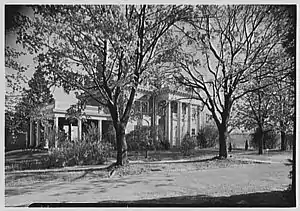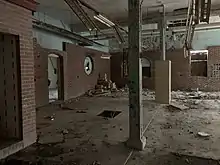United States Naval Training Center, Bainbridge
United States Naval Training Center, Bainbridge (USNTC Bainbridge) was the U.S. Navy Training Center at Port Deposit, Maryland, on the bluffs of the northeast bank of the Susquehanna River. It was active from 1942 to 1976 under the Commander of the Fifth Naval District, based in Norfolk, Virginia.

Located on the appropriated campus of the Tome School for boys, the training center sat between various important naval centers of World War II: about 35 miles (56 km) northeast of Baltimore, Maryland, and 75 miles (121 km) from Washington, D.C., and Philadelphia, Pennsylvania. It was reached via Maryland Route 222, about halfway between US 1 and US 40.
History
Origin
President Franklin Delano Roosevelt personally approved the site, which was seized from the Tome School by Congressional order. Roosevelt also chose the name to honor Commodore William Bainbridge, who commanded the frigate Constitution when it defeated the British frigate HMS Java during the War of 1812.
The campus was expanded by government purchase from 330 acres (1.3 km2) to 1,132 acres (4.58 km2). More than five hundred new buildings were built, some designed by Eggers & Higgins.
Recruit training
The center was activated on 1 October 1942, and the first batch of recruits arrived 10 days later to begin "boot camp" training. They came in busloads from transportation collection points at Havre de Grace and Perryville, Maryland. The recruits were given a battery of tests to determine their educational and skill levels, then trained in ordnance and gunnery, seamanship, fire fighting, physical training, and military drill.
Recruits were trained in shipboard duties aboard the R.T.S. Commodore, a 200-foot "ship" built on dry land. The trainer was equipped with deck guns, a pilot house, davits with whaleboats, and mooring lines fastened to earth-bound bollards, so that crew members could learn casting off hawsers and other lines connecting the ship to its dock.
Halfway through boot camp, recruits had a "service week", which generally included kitchen duty, peeling potatoes, mopping, picking up cigarette butts, etc. Recruits with desirable skills, such as typing, could end up on an office typewriter rather than in a kitchen. One winter, recruits were sent to shovel snow off roads to a largely rural area near Colora and Rising Sun.
By the end of World War II, the center had trained 244,277 recruits who transferred to various ships and stations throughout the world.
Non-recruit training
USNTC Bainbridge also trained new boot camp graduates and other sailors in technical and other skills. During World War II, 24,484 sailors completed various programs under the direction of the Service School Command[1].These included:


- Coast Guard School
- Rockefeller Research Unit (Report to Naval Training Station).
- Stewards Mates' School Roll
- Naval Academy Preparatory School, founded in 1943.
- Naval Hospital
- Hospital Corps School
- Naval Training School (Radio)
- Naval Training School (Fire Controlmen)
- Fire Fighters School
- Naval Training School (Electrical)
- Naval Training School (Physical Instructors)
- Naval Training School (Instructors)
- Naval Training School (Sound Motion Picture Technician)
- Fire Fighters Training Unit
- Naval Training School (Motion Picture Operators)
- Naval Training School (Recruit Instructors – C)
First deactivation
After the war, the center continued limited operations until 30 June 1947, when it was first inactivated as a Navy training center. The sole remaining training activity on campus was the Naval Academy Prep School. A maintenance staff remained active to protect the buildings from weather and other damage.
Reactivation
In mid-1950, with the advent of the Korean War crisis, plans were made to reactivate the center, and it was officially reopened on 1 February 1951, with Captain Robert Hall Smith in command.
Despite the care of the maintenance staff, the buildings were in severe disrepair. A contract was awarded to Consolidated Engineering Company of Baltimore, Maryland. The necessary renovations and road work were accomplished ahead of schedule, and the center reopened its gates for recruits on 5 April 1951.
Initially, the center admitted 500 recruits per week, but the rate soon doubled. The first class of 500 seamen recruits graduated on 23 June 1951.
In 1962, a Naval Nuclear Power School was installed on the center; this was eventually moved to Naval Training Center Orlando, Florida.
NAPS moved to Newport, Rhode Island, in August 1974.
Second deactivation
The Navy deactivated the Center on March 31, 1976[2] and on the evening of June 30, 1976, Chief Petty Officer Stephen Kowalki locked the gates for the final time.[3] Some of the facilities were used by the Department of Labor as a Job Corps Training Center until 1990.
Base closing

On 3 November 1986, the United States Congress authorized the Secretary of the Navy to dispose of Naval Training Center, Bainbridge by sale to private parties or transfer to other government agencies. NTCB is the federal facilities equivalent of a brownfield site; the Navy's primary goal was effective re-use of the former property by the State of Maryland and the people of Cecil County. Congress specified that before any sale, the Secretary of the Navy was required to "restore such property to a condition that meets all applicable Federal and State of Maryland environmental protection regulations" (Public Law 99-956).
21st century
As of June 2006, the U.S. Navy had transferred this site to the Bainbridge Development Corporation and declared the cleanup complete.[4]
Various buildings have since caught fire, including:
- On September 21, 2014, the main building at the Tome School on the Bainbridge Naval Base property caught fire, leaving only a skeleton of the building.[5] This was later ruled to be arson.[6]
- On February 10, 2019, an abandoned home on the property caught fire. [7]
- On May 6, 2020, a wooden/stone two-story home-style building, once a part of the Tome School, caught fire and burned to the ground.[8][9]
- On June 12, 2020, a large stone building caught fire.[10] Crews arrived to find the roof already collapsed. They let the building burn completely and ruled it a total loss.
Offers have been made to the Bainbridge Development Corporation, or BDC, the property owner, about crowdsourcing funds to restore the buildings due to their dilapidated state, historical value, and the financial strain they have placed toward fire departments' resources. The BDC is "a public instrumentality of the state of Maryland." and "State entities are not authorized to use crowd funding sources of any kind."[11]
Professionally monitored cameras, provided by DeepSentinel, have since been installed and activated at the Tome School site, and have the ability to detect and communicate with intruders, and the ability to automatically call police if an intruder continues to loiter. This is a long-term solution to the preservation of the three remaining buildings.
Organization
The center was divided into four activities, each with its own commanding officer:
Administrative Command
The Administrative Command was responsible for the various tasks and services necessary in running a center containing about 35,000 inhabitants. Tasks included base maintenance, physical security, fire protection, logistics, material procurement, medical care, religious services, transportation, and so on.


Recruit Training Command
The Recruit Training Command was the largest of the center's commands and was responsible for the basic training of recruits. It consisted of four independent commands – known as camps—each of which had its own regimental drill hall, mess hall, barracks, class rooms, and so on:
- Camp Rodgers
- Camp Perry
- Camp James
- Camp Barney
Each camp contained 5,000 male recruits. A training school was established for WAVE recruits in October 1951. Circa 1959, male recruit training at Bainbridge was closed and male recruit training was only in Great Lakes, Illinois and San Diego, California. Bainbridge was the sole recruit training center for Waves until moving to Orlando, Florida in 1972.
Service School Command
The Service School Command was organized to train selected personnel who had completed "recruit" basic training and demonstrated an aptitude for a skill during initial recruit testing. The command had a capacity of providing specialty training to 4,000 sailors at a time. These personnel were assigned to training in gunnery, fire control, radio, telemetry, and other technical subjects.
The Naval Academy Preparatory School was a component of the Service School Command and was chartered to train enlisted personnel for acceptance into the U.S. Naval Academy at Annapolis, Maryland. The school also trained sailors and marines in necessary academic skills required for admission to colleges and universities under the Naval Reserve Officers Training Corps.
Naval Hospital
The naval hospital was established as a 500-bed hospital to care for the center's operating staff, recruits, students, and dependents, with provision to increase capacity to 1,000 beds or more. Some care was provided by the roughly 1,200 students studying to become Hospital Corpsmen at the Hospital Corps School.
Famous people who served at the USNTC
- Charlie "Choo Choo" Justice, University of North Carolina at Chapel Hill football star & two-time Heisman Trophy runner-up.
- Admiral Frank B. Kelso II (1933–2013), who later became Chief of Naval Operations, commanded the U.S. Naval Nuclear Power School at the U.S. Naval Training Center Bainbridge from 1969 to 1971.
- Paul Pierce, who later became head football coach at Sul Ross State University and Sam Houston State University.
- Bill Cosby, Actor, comedian and convict.
See also
References
- United States Naval Facilities World War II
- "Dec 7, 1941 - Cecil Goes on a War Footing & Bainbridge Develops". Window on Cecil County's Past. 7 December 2008. Retrieved 31 March 2020.
- admin (5 August 2009). "Last Sailor at Bainbridge Says Goodbye to Friends at the Winchester Bar". Window on Cecil County's Past. Retrieved 31 March 2020.
- "Current Site Information, Naval Training Center Bainbridge, MD Superfund | Mid-Atlantic Superfund | US EPA". 21 September 2015. Archived from the original on 21 September 2015. Retrieved 14 June 2019.
- Reimer, By Susan. "Authorities investigate fire at former Bainbridge Naval Station". baltimoresun.com. Retrieved 7 May 2020.
- Vought, Allan. "Bainbridge building fire ruled arson; probe continues". baltimoresun.com. Retrieved 7 May 2020.
- [email protected], Marcus Dieterle. "Fire on Bainbridge property under investigation". Cecil Daily. Retrieved 7 May 2020.
- "Bainbridge Fire: Crews Fighting Port Deposit Blaze". Havre de Grace, MD Patch. 6 May 2020. Retrieved 7 May 2020.
- staff, Aegis. "Fire destroys building at former Bainbridge naval site in Cecil County". baltimoresun.com. Retrieved 24 June 2020.
- "Officials Investigating After Fire At Former Bainbridge Naval Training Center In Port Deposit". 13 June 2020. Retrieved 24 June 2020.
- Email from Toni Sprenkle, director of the Bainbridge Development Corporation. "The Tome School is owned by the BDC, a public instrumentality of the state of Maryland. State entities are not authorized to use crowd funding sources of any kind. We appreciate your interest, but you cannot raise money to restore property owned by the state. The Go Fund Me page needs to be removed immediately. And I will be forwarding this onto our States Attorney who may contact you if the page is not removed. Again, I appreciate your enthusiasm. Kindly, Toni Sprenkle Sent from my iPhone Please excuse brevity and typographical errors"
- The Compass, United States Naval Training Center, Bainbridge, Maryland. Atlanta, Georgia: Albert Love. 1954.